Editor of this issue: Antanas Klimas
Copyright © 1967 LITUANUS Foundation, Inc.

|
LITUANUS
LITHUANIAN
QUARTERLY JOURNAL OF ARTS AND SCIENCES
Volume 14 13, No.2 -
Summer 1967
Editor of this issue: Antanas Klimas ISSN 0024-5089
Copyright © 1967 LITUANUS Foundation, Inc. |

|
BALTO-SLAVIC OR BALTIC AND SLAVIC?
(The Relationship of Baltic and Slavic Languages)
ANTANAS KLIMAS
The University of Rochester
There is quite a bit of interest again in the question of the relationship between the Baltic and Slavic branches of the Indo-European languages. This can be a-scribed to several reasons:
1. This
problem has never been solved to everyone's satisfaction.
2. The V-th International Congress of Slavicists,
which was held in Sofia in 1963, created a special Committee of sixteen
members whose task it is to sponsor the more thorough investigation of
this problem and to suggest definite conclusions or recommendations by
about 1968, the year when the Vlth International Congress of Slavicists
is to be held.1
3. Several books and some dozens of articles dealing with this
problem have appeared since 1945 in many countries, their views being
at great variance with each other.
4. The solution of this problem if a solution is really
possible, would help reduce the great confusion in introductory texts
and bibliographical arrangements, especially in the English-speaking
countries.
5. A solution would contribute, generally, to linguistic
knowledge, particularly on the geneological relationships between
languages.
There are as many attitudes on this question as there are linguists dealing with some phase of Indo-European linguistics, particularly Baltic, Slavic and Germanic. To a certain degree, linguists dealing with questions of Finno - Ugric linguistics are also concerned with this problem, especially in discussing the ancient Baltic (i. e., Proto-Baltic, Proto-Lithuanian, Proto-Lat-vian, etc.) loanwords in the Baltic Finnic languages such as Livian, Estonian and Finnish.
Let us now examine some samples of these attitudes and views:
In his recent book Areal'nyje aspekty balto-slav-janskix yazykovyx otnoseniy (Areal aspects of the relationships of Balto-Slavic Languages)2, A. P. Nepokupnyy very categorically states in his introduction to the book the following:
The problem of the Balto-Slavic linguistic relationship — (which is) one of the basic problems of Slavistics and, generally, of Indo-European linguistics — has existed in comparative linguistics from the very beginning in one or another form. The central question in this problem: did there exist a Balto-Slavic linguistic and ethnic unity, and how is one to understand it (if it did)? This central question has been a topic of discussion for more than half a century.3
This is to say, that, at least in Europe, this question is one of those controversial problems which does not easily lend itself to a final solution.
On this side of the Atlantic, there is no such great universal interest in this question; however, the problem remains very much alive. This general lack of interest can perhaps be ascribed to two reasons: 1) Few linguists in the United States and Canada have a deep interest in Slavic and Baltic linguistics; 2) Generally, the interest in historical linguistics here, as was stated recently, is "under a cloud."4
Several scholars who show some interest may be said to be trying after a fashion, as one of my collagues expressed it, to have the attitude of an unbiased observer in this controversy. I would like to quote one such o-pinion, that of Professor Lehmann:
The lateness of texts from both groups has made it difficult to determine precisely their interrelationship. Some scholars class both of them in one subgroup of Indo-European, Balto-Slavic. Others maintain that the similarities between the Baltic and the Slavic languages are due to mutual influences exerted during a long period of contact. These scholars set up two independent subgroups of Indo-European, Baltic and Slavic. A choice between the two depends on the interpretation of minute characteristics in materials that have come down to us. We can scarcely state with assurance whether one subgroup or two are to be posited, given only recent materials.5
In other words, a cautious scholar who is not sure of what Professor Lehmann refers to as the "minute characteristics in materials that have come down to us" will leave a question mark here and will go no further, rather than risk making a wrong judgment, or even to set up a shaky hypothesis.
But a few scholars, as we shall see later, although they seem not to have enough knowledge about these "minute characteristics," (as a matter of fact, some of them do not seem to have enough fundamental knowledge about the big characteristics either) — nonetheless proceed to make ambitious statements.
It is impossible to deal, in this paper, with all aspects of this question. We cannot, for example, go through the complex history of this problem. We cannot go deeply into the discussion of the principal theoretical question: What really constitutes a linguistic unity, or close affinity, of two languages, or of two language groups?
Therefore, I propose just to take a brief glance at: a) what has been done in this problem since about the middle of the 19th century, b) what the situation now is, and c) what the prospects for the future are.
We will see that in practically all contributions to Indo-European linguistics in the 19th century the Baltic and Slavic languages were either "lumped together" or classified as very close to each other at the very least. The reasons for that were very simple:
1.
Nineteenth century scholars did not know much about these languages.
Very little was known about the Baltic languages, especially.
2. The materials that linguists had
available were primarily old translations into these languages from
religious texts, plus some items of folklore. In the Baltic languages
these texts were full of newly borrowed loanwords from Polish, Russian,
Byelorussian, and German. But this fact, as we know today, does not
show any closer genetic
relationship, but simply a recent one-sided influence: Slavic upon
Lithuanian and, generally, upon Baltic.
By the way, the term Baltic (baltische Sprachen) was introduced by Nesselmann only in 1845, and it was widely accepted some years later. Before that time, one or another name for Lithuanian (littauisch, litauisch, litu-slawisch, lettisch) was used in various applications.
Let us now take a look at the main points in the expressed or implied classification patterns of the Indo-European languages in the 19th century. They were all, of course, based on posited genetic, or geneological relationships.
I. One of the earliest attempts to classify the Indo-European languages was made by Professor A. F. Pott in the middle thirties of the 19th century (published about 1833). His classification appeared as follows:
1. Old
Indic, or Sanskrit
2. Medopersian (Iranian)
3. Greek and Latin
4. Lithuanian and Slavic
5. Germanic
Only the languages or language groups listed above were known then to be Indo-European. There is no mention in the listing by Pott of Celtic, Albanian, Armenian, etc.
II. Professor Lottner (in Zeitschrift fuer vergleichende Sprachforschung, known as KZ - Kuhn's Zeitschrift, after Professor Adalbert Kuhn, the founder, Vol. VII, 1858, p. 18 ff. and 161 ff.) expresses his views concerning the geneological relationship of the Indo-European languages, which can be schematized as follows:
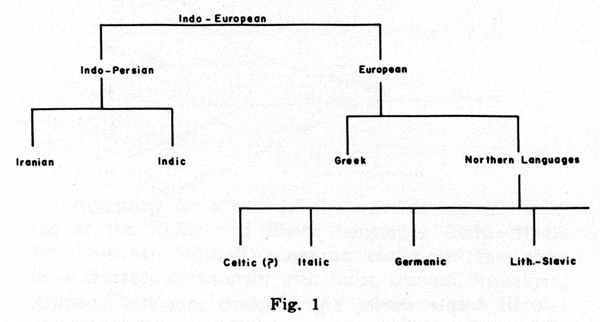
One cannot expect anything else: Professor Lottner was not too well acquainted with the Baltic and the Slavic languages.
III. August Schleicher (ca. 1860_
In some of his works, the famous creator of the family tree (Stammbaum) presented the following classification (or division) of the Indo-European languages:
1. Asiatic or
Aryan languages: Indie, Iranian, Armenian
2. Southwest European languages: Greek, Albanian,
Italic, Celtic
3. North European languages: Slavic, Lithuanian,
Germanic
(Cf. Compendium der vergleichenden Grammatik der indogermanischen Sprachen, 1861, p. 4 and ff.)
Later in his scholarly work Schleicher, influenced by his studies of life sciences, devised the famous family tree (Stammbaum) to explain the interrelationships of the Indo-European languages. This Stammbaum, in one or another form, is still being used by many people working in linguistics. Its simple outline would be:
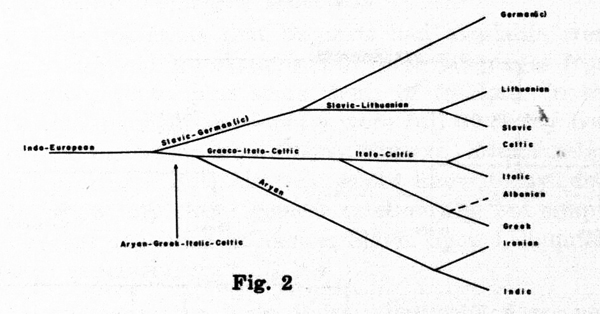
In simple words, Fig. 2 means that the proto-lan-guage (Proto - Indo - European, German: Urindogermanisch) first split up into two main groups: Baltic, Germanic, and Slavic on the one hand and the rest of the Indo-European languages on the other. Later, various further splits took place, until one sees the "final" picture as represented by the smallest branches of the "tree" on the right.
IV.
Another milestone in the classification of the Indo-European languages
was created by Professor Johannes Schmidt and his wave-theory
(Wellentheorie) about 1860. He did not believe in a "straight line"
development, and this "branching off" as it was seen in the family tree
of Schleicher. He proposed the wave-theory which states that linguistic
changes are similar to waves radiating in more or less circular
directions like waves from the center of a disturbance. This would
account for various and complicated influences of one group upon
another, etc. In a rough outline, his wave-theory could be
schematically represented as follows:
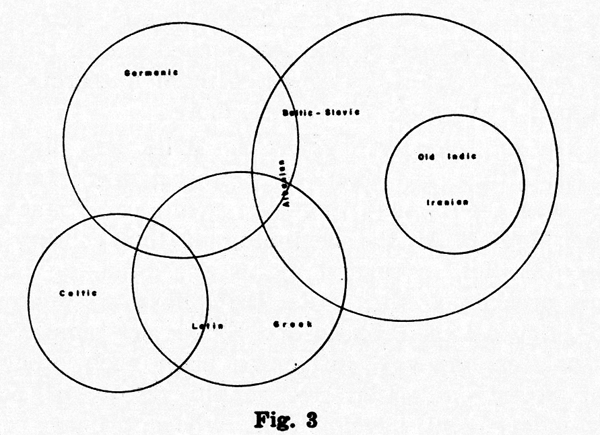
Accepting for a moment the wave-theory and looking at the Baltic and Slavic languages (Baltic-Slavic for Johannes Schmidt), one can easily see that they have features in common with Indie, Iranian, Armenian, Thraco-Phrygian, Latin, Greek, Albanian and Germanic languages. Only Celtic seems to be standing apart.
In looking back at all these classifications (Pott, Lottner, Schleicher, Johannes Schmidt), one thing becomes clear: the Baltic and the Slavic languages are shown as the latest, or youngest, "twigs" of the common Baltic-Slavic, or Baltic-Slavic-Germanic branch. Reasons were mentioned above for this kind of rather careless handling of the problem. In a way, it may be said that it was not yet a problem in those days, since too little was known of both branches, Baltic and Slavic. Historically, too, one must keep in mind that Lithuania and Latvia were at that time occupied by Tzarist Russia, which made the availability of and the accessibility to the Baltic languages rather difficult.
Only in the 20th century did scholars begin to doubt the idea of common origin, or "unity," of Baltic and Slavic. With linguistic advances, they were able to look deeper into the more important and more basic features of the linguistic structure of both groups. And the more they penetrated into the older structure of these two groups, the less similar they appeared. Most of the previously assumed similarities turned out to be primarily only late transfers from the more numerous Slavic speakers upon their Baltic neighbors.
The first scholar to reject the Baltic and Slavic unity (and, thus, the assumed proto-language, Balto-Sla-vic) was the famous linguistic genius of France, Antoine Meillet. At the beginning of this century, Professor Meillet, in several of his epoch-making publications proclaimed the notion that the few apparent similarities between Baltic and Slavic are simply either mutual, or one-way, influences upon each other, and that other similarities are simply results of parallel but independent developments whose primary origins most probably go back to the very Proto-Indo-European itself. Meillet's views could be schematized as shows in Fig. 4.
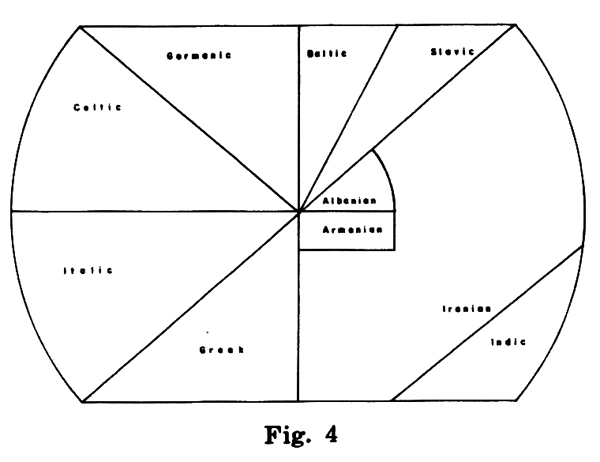
Reinterpreting and adding some well known facts, one could add more explanations to Meillet's views:
a)
Old Slavic, Russian, Byelorussian and Polish words which were borrowed
into the Baltic languages ca. 1000 A.D. - 1800 A.D., and which can be
found in the older Baltic linguistic documents, do not show any close
relationship. One can think, for example, of hundreds of Latin words
which were taken over into German, or into English, but the existence
of these words in these two Germanic languages does not show any close
genetic relationship between, let us say, Old Germanic and Old Latin.
Modern Persian, a direct descendent of Iranian, is now full of Arabic
words, but they mean nothing as far as the origin of Persian is
concerned. Or, take Modern Rumanian: there are hundreds of Slavic
loanwords of various types in Rumanian, but, by origin, it is clearly a
Romance language, a descendent of Latin,
b) Meillet understood one basic fact: since both groups —
Baltic and Slavic — are quite conservative and archaic, they
both have preserved, even until the present day, many a feature
inherited directly from Proto-Indo-European, features which most of the
other living Indo-European languages have lost. Let us mention in this
connection a simple example.
When someone who is not a trained historical linguist sees that in Lithuanian the words "when" and "then" are kada and tada and that these same words are in Russian kokda and togda (pronounced: kagda, tagda), he usually jumps to a hasty, but perhaps understandable, conclusion: „Gee whiz, Lithuanian and Russian are very similar, and they sound alike." But this person usually does not know that in Old Indie (Sanskrit) the very same words are also kada and tada! And one can find hundreds of similar examples.
At this point, I would like to interject my firm belief that if even one of the two branches had changed as much as any Germanic language or any Romance language had changed in the same time, or if they had simply diverged from each other, nobody today would even dream of talking of any close relationship between Baltic and Slavic.
Around the end of the 19th century, the whole notion of deciding about close genetic relationship between languages, or language groups, became much more clearly delineated. In the past, some scholars considered vocabulary (lexical) similarities to be the most important criterion for establishing the degree of relatedness between languages. But in the second half of the 19th century it was established that the lexical similarities are the weakest criterion for that purpose; individual words of many varieties and types can be borrowed very easily, and can be adopted in many ways.6
More and more linguists began considering the phonological (sound) and morphological (inflectional, word-formational) features to be the ones which do not change so easily, and which are usually not borrowed from one language into another.
By the end of the 19th century it was accepted that the most important criteria for establishing the degree of relatedness between languages are morphological, phonological, syntactical, and only finally lexical similarity, in that order. Moreover, only those similarities should be considered for this question which can be found only in the two languages or language groups under consideration and nowhere else. Only then (but not necessarily even then), these similarities may mean that they are common innovations having occurred only in this particular area, pointing in a certain degree to a common ancestor, i. e., the same prototype, proto-language.
And, strange but true, until the present day, what linguists have done was simply to count the similarities between Baltic and Slavic. So it happened that the more similarities someone assumed he had found, the more firmly he would come out for the "unity" of Baltic and Slavic.
Meillet was the first to point out that there never had been one common ancestor, "Proto-Balto-Slavic," but that Baltic separately and Slavic in its turn, also separately, developed directly from Proto-Indo-European. The few similarities which Meillet believed could be found between Baltic and Slavic were to him either a) inherited (or preserved) from Proto-Indo-European or b) parallel, but separate developments.
However, not every linguist accepted Meillet's views, in spite of his reputation as a great Indo-Europeanist.
Presented below, we will see two subsequent schemes in which Baltic and Slavic are reunited. The first one is more or less the view of a few linguists who based their conclusions on the early findings of linguistic geography (dialectology, in its broad sense) around 1920-1930. (Fig. 5)
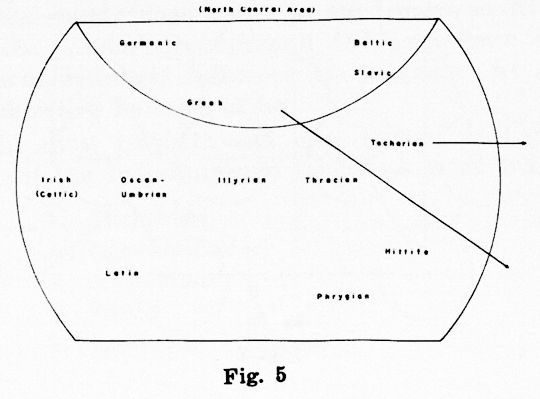
In 1928, the Italian Professor Pisani also came out for unity. His views are schematized below:
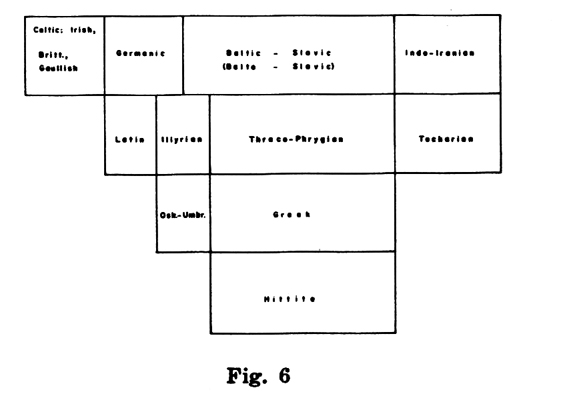
However, another Italian scholar, Giuliano Bonfante (now professor at the University of Turin) firmly rejected the notion of Baltic and Slavic unity. His basic views can be expressed as follows:
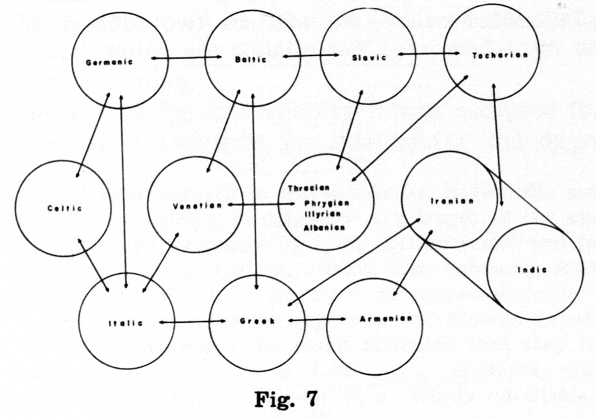
Professor Bonfante also believes that:
a)
There is a definite Western Group (Italic, Celtic, Germanic, etc.)
b) There is an Eastern Group consisting
of Indo-Iranian and Slavic.
c) There are also "connecting links"
between the
Western Group and the Eastern Group; in the North, Baltic, which is
closer to the Western Group, and in the South, Greek, which is closer
to the Eastern Group.
It is interesting to note that Pisani and Bonfante, both Italian scholars, have come to completely different and opposing conclusions concerning this problem. It is most probably because Pisani knows the Slavic languages much better and is not so well versed in Baltic languages. It is as in almost all other known cases: whenever a scholar not descended from Slavic peoples or Baltic peoples tries to solve this problem, one can usually observe that if the particular scholar first learned and studied Slavic languages, he tends to favor the "unity" of Baltic and Slavic (Vaillant, Szemerenyi, Entwistle, Morison, etc.). Those scholars, however, who became thoroughly acquainted with Baltic languages first (and primarily those who came to know the Baltic languages firsthand) tend to be against Baltic and Slavic "unity." And there are, of course, various intermediate attitudes.
This simply shows that in any controversial question, the scholar's background and experience in the field will definitely influence his judgment, no matter how objective he tries to be.
The most frequent and most widely used classification of the Indo-European languages is as follows:
1.
Tocharian
2. Indo-Iranian
3. Armenian
4. Hittite
5. Anatolian languages
6. Thracian
7. Phrygian
8. Illyrian
9. Albanian
10. Greek
11. Italic (or Romance languages)
12. Celtic
13. Germanic
14. Baltic
15. Slavic
One has to add here immediately that practically every scholar of Indo-European linguistics will present his own classification. Some will consider, for example, Thracian and Phrygian as one group, Thraco-Phrygian. Others count Hittite together with the Anatolian languages (recently discovered in Asia Minor and Syria), Lydian, Lycian, Luwian, etc. Still others consider Oscan-Umbrian as a separate group, while the majority tend to include Oscan-Umbrian in the Italic group. And so on, without end.
Professor Antanas (Anthony) Salys, now at the University of Pennsylvania, in 1956 published a very ingenious scheme in regard to the classification of the Indo-European languages.7 In my opinion, it is the best scheme to date; it combines together the best features of the wave-theory, while at the same time it is primarily based on modern linguistic geography.
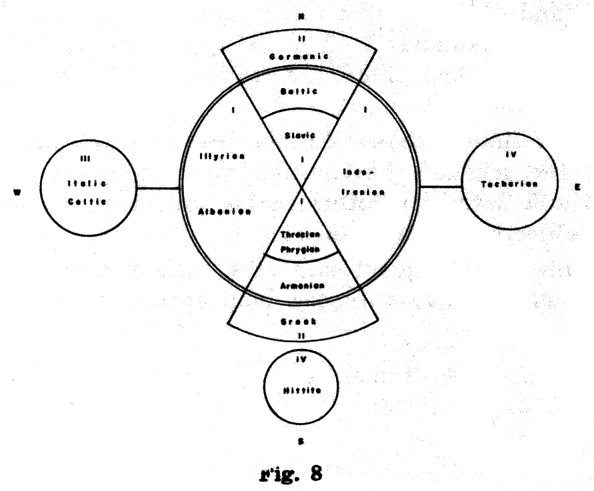
Professor Salys' diagram could be further clarified by these observations:
a)
The satemization process (see below) is a later development that the
split-up of Tocharian and Hit-tite from Proto-Indo-European. Thus,
satemization is not an all-pervading division of these languages.
b) Salys assumes the so-called
"away-from-the-center-gradation," i .e., the central groups and the
peripheral groups.
c) He assumes the Indo-European expansion
going more or less in all four basic directions.
d) At the end of the Indo-European
expansion, the
peripheral groups (marked in the diagram with II, III, IV) more or less
surrounded the central groups (marked I), so that the satemization
process (palatal k and g becoming š and ž respectively)
never
reached groups II, III, and IV.
The following list and diagram represent the present writer's attempt to classify these languages:
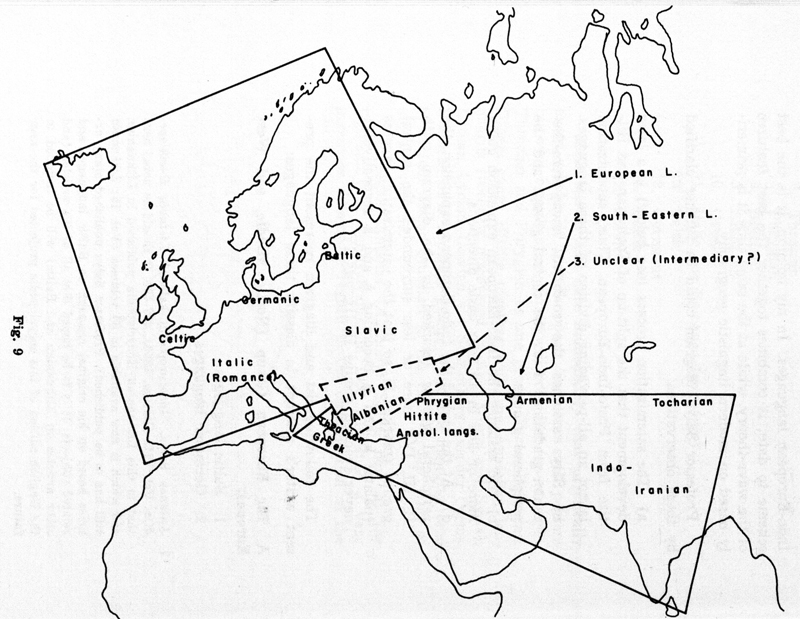
A. The European Group (North, Middle, and West Europe):
1.
Baltic languages
2. Germanic languages
3. Slavic languages
4. Celtic languages
5. Italic (Romance) languages
B. South-Eastern Linguistic Area Languages (South-Eastern Europe, Asia Minor, Persia, Afghanistan, Turkestan, Northern India):
1.
Greek
2. Thracian
3. Phrygian
4. Armenian
5. Anatolian languages
6. Hittite
7. Indo-Iranian
8. Tocharian
C. "Intermediary" Languages:
1.
Illyrian
2. Albanian
In approximate geographical distribution, ca. 2500-1000 B. C.., one could imagine these basic 15 groups being spread as shows Fig. 9.
Turning our attention now to the basic question, let us glance briefly at the basic historical developments of the Baltic languages. It can be schematized as follows in Fig. 10.
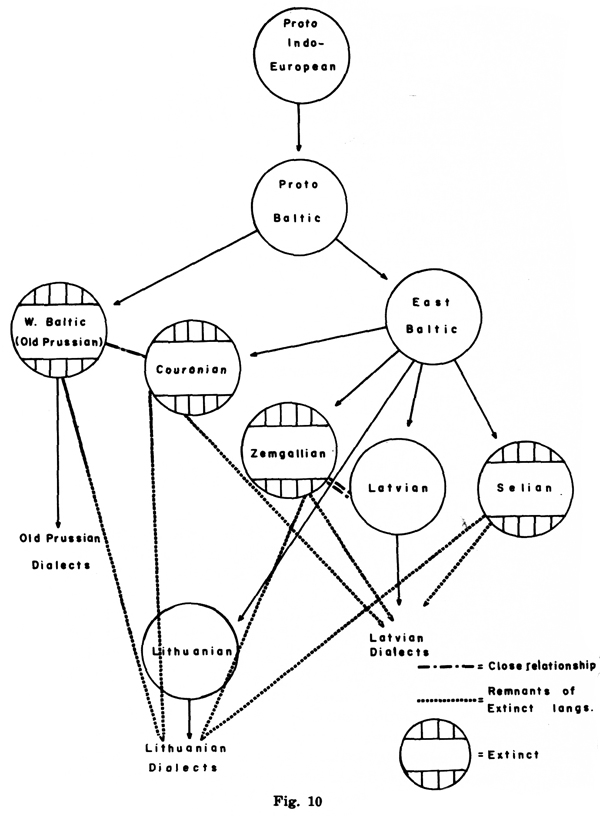
Although most of the main textbooks on Indo-European- linguistics mention only three Baltic languages, Old Prussian, Lithuanian and Latvian, in Baltic linguistics we usually count six Baltic languages. These are the ones listed above and Couronian (or Courish), Zemgallian (or Samigollian), and Selian (or Selonian). Of these, only Lithuanian and Latvian are spoken today. Old Prussian died out in the 17th century. Couronian, Zemgallian and Selian were absorbed by Latvian and Lithuanian ca. 1200 A. D. - 1500 A. D.
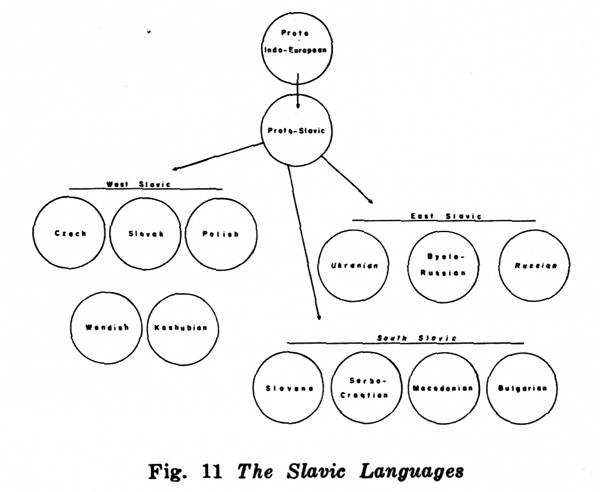
In the figure below, our last figure, are found the basic opinions or views concerning the origin of the Baltic and Slavic languages:
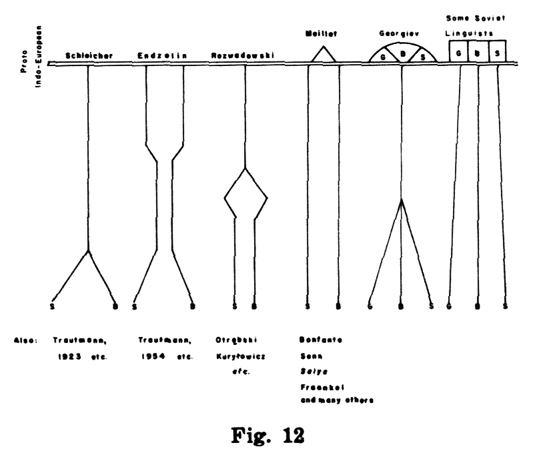
We will turn now to our real task, which is to take a closer look at those similarities on which these deductions are usually based. There is no space in an article of this kind to dwell on everyone's enumeration, or even discussion of the similarities. It will be sufficient to pick one or two samples to see how divergent are the attitudes concerning this problem.
The latest two, and by far the most important, contributions are those of Szemerenyi <1957) and Senn (1963, published in 1966).8
Professor Szemerenyi claimed to have found the following fourteen of the "most important innovations" between Baltic and Slavic:
1. The BS palatalization
2. The development of i, and after velars u before IE ṛ ḷ m ŋ
3. s becoming š after i u r k
4. Accent innovations
5. Definite adjective
6. Participle-inflection in -yo-
7. Gen. sg. of -o-stems in -ā(t)
8. New comparative formation
9. 1. sg. obi. * men- (mun-); 1. pi. * nosom
10. tos/tā for IE so/sā
11. Balto-Slavic * domi/dosi/dost-/dodnt-
12. Balto-Slavic preterit in -ē/ā-
13. Verbs in -auju = ujo
14. "Vocabulary agreements and innovations"
Unfortunately Szemerenyi's knowledge of the Baltic languages seems to be second-hand; he simply does not know enough about the Baltic languages to make such decisions. Most of his arguments are based on quotations, paraphrases, and interpretations of other scholars' research, including that of Meillet, but especially of Kurylowicz and Vaillant. The latter two, inspite of their fame as leading linguists in certain fields, appear to be deficient in their knowledge of the Baltic languages.9
In his latest article on this problem, Professor Senn (who has an excellent first-hand knowledge of practically all the Baltic and Slavic languages) discusses the fourteen similarities claimed by Szemerenyi and finds that only numbers 6 and 9 are wholly acceptable. All the others in reality do not exist.
We will not go into detailed discussion here, because this article is already rather lengthy. I would like, however, to point out some really grievous mistakes in Szemerenyi's listing.
a) In reference to Szemerenyi's no. 1, it is clear that he did not realize that the Baltic palatization occurred in his sense only in Latvian, not in Old Prussian and not
in Lithuanian. The Lithuanian palatalization occurred later, and it was
of a different character. Thus, there was no common palatalization at
all in Proto-Baltic. Szemerenyi's type of palatalization has to be
ascribed only to Slavic, Latvian palatalization occurring then, most
probably, under the influence of Russian, and not as a commonly
inherited feature.
b. In reference to Szemerenyi's no. 2, it must be stated that similar developments also occured in Germanic. Thus, it cannot be assumed to have been a Balto-Slavic innovation.
c.In number 3, Szemerenyi simply shows that he is not thoroughly enough
acquainted with Baltic linguistic problems. If he were, he would never
have listed this item. The real situation in Baltic is this: the s became š in Baltic only after r and k, not after i and u.10
This is a very ancient, and thus a very important development. On the
other hand, Slavic agrees here 100 % with Indo-Iranian, so that even if
it were true for the Baltic languages as well, this could never be
accepted as a Baltic-Slavic innovation because, as was just mentioned,
it also occurs — exactly as in Slavic — in Indo-Iranian,
especially in Sanskrit. How Professor Szeme-renyi failed to mention
that fact, I fail to comprehend.
d. Szemerenyi's "innovations" 7, 8, and 10 did not take place in all
Baltic languages, i. e., 8 did not take place in Latvian, 7 and 10 did
not take place in Old Prussian. Thus, they are really very recent
innovations occurring only in individual Baltic languages. They did not
exist in the Common Baltic (or Proto-Baltic) period. Certainly, then,
they have absolutely no common origin with occurences in Slavic. Some
of them may be a later influence of Slavic, but this may show only a
long association, not a common origin.
e. The least defensible is Szemerenyi's last "innovation," no. 14.
According to him, it is enough just to glance at the vocabulary
listings of Baltic and Slavic languages, and one will be convinced that
there must have been a common protolanguage. But even Professor
Reinhold Trautmann himself, whose dictionary Szemerenyi mentions,11
announced in 1954 that he is no longer in favor of the concept of
Baltic and Slavic unity ("Einheit"), but only of historically
neighboring community ("Gemeinschaft").
Recently, with the help of my students, I checked the supposed lexical innovations found only in Baltic and Slavic against the newest findings in etymological works. The result is that only 16-20 lexical items can be considered as occurring only in Baltic and Slavic. All the others can be found in one or more other branches of the Indo-European languages. One can compare that result with the lexical stock common only to Baltic and Germanic languages. There are at least 72 such words, though no one has yet posited a common Balto-Germanic proto-language.12
Thus, the real similarities between the Baltic and Slavic languages can easily be reduced to about four:
a) The ending -mus in the dative plural. But even here one has to keep in mind that Germanic languages also definitely show the m-element in their dative plural;
b) some similarity in forming the oblique cases of the first person singular;
c) similarity in forming some forms of the first person plural;
d) perhaps also the change from the -nt- stem inflection to the -jo- stem inflection of participles. However, some traces of this development can also be found in Germanic.
As we have just seen, the real similarities, or innovations between the Baltic and Slavic languages are very few indeed. Such a number of similarities could, as a matter of fact, be found in many a pairing of Indo-European languages. This small number of rather insignificant innovations in Baltic and Slavic certainly does not warrant an assumption of a common ancestor, intermediate to Proto-Indo-European. Thus, the idea of a Balto-Slavic unity must be rejected, though there have even been occasional attempts to reconstruct the assumed "Balto-Slavic Protolanguage."13
We now will list the main differences between Baltic and Slavic, as a double check on our conclusions. This will clearly show that it is impossible to reconstruct the supposed Proto-Balto-Slavic at all, a potent proof that it really could not have existed. To our knowledge, this discussion of differences between Baltic and Slavic is being presented in this scope for the first time. By the way, the sequence of listing does not indicate the degree of importance to be attached to these differences.
These, then, are the main differences between Baltic and Slavic:
1. In general, the phonological structure of Baltic
languages has always been much more conservative than that of the
Slavic languages.
a) In vocalism, Baltic preserved almost all long Indo-European vowels; in Slavic there were many changes.
b) In the development of short vowels, Baltic stands much closer to Germanic than to Slavic; short o became short a both in Baltic and Germanic, but not in Slavic. Compare Latin octo, "8," Lith. aštuoni, German acht, but Russian vosem.
c) Baltic languages preserved a number of old Indo-European
diphthongs which were completely lost in Slavic at a very early period,
d) Original consonantal systems of the Baltic languages were also much
better preserved than those of Slavic.
2. In Baltic, in very numerous cases, the final consonants have been preserved, as well as many final diphthongs. In even a very archaic form of Common Slavic, these did not survive. For example, Old Lithuanian, and Modern Lithuanian sūnus 'son' compared with Old Church Slavic synu, in which the final s disappeared very early.
3. Only in Baltic languages, the m before t was preserved. It was shifted to n in most other Indo-European languages, and in Slavic it disappeared completely: Proto-Indo-European (reconstructed form, thus marked with an asterisk, or star, *) * kmton '100,' Latin centum, German hundert, English hundred, Slavic suto, but Lithuanian šimtas, Latvian simts. Now, in any word where -mt- occurs, it is totally impossible to reconstruct the form for "Proto-Balto-Slavic," since the form has to be reconstructed with m, and that form is already a Proto-Indo-European form.
4. Already in the Proto-Baltic era, the inherited Indo-European -j- disappeared from all Baltic forms where it was followed by a front vowel (i, e) and preceded by a consonant. This did not happen in Slavic. Thus, the Proto-Baltic form *jautjo 'I felt' had to become Modern Lithuanian jaučiau because the -j- was here preserved and the -tj- was later shifted to -č-. But the 2nd person singular of the same verb in Proto-Baltic (*jautjie) later produced the Modern Lithuanian form jautei. This phenomenon did not take place in Slavic at all.
5. The feminine -jē- stem nouns, which were very numerous in Proto-Indo-European, were preserved completely unchanged in Baltic, but were replaced in Slavic; thus, Lithuanian žemė 'earth,' Slavic zemlja.
6. In the Baltic verbal system, the form of the 3rd person singular replaced completely and totally the 3rd plural (and dual) verbal forms in very early times, as a matter of fact, so early that not a trace is left of the 3rd person plural. The Slavic languages, all of them, until the present time, carefully separate the two forms for singular and plural. I am convinced that if there had been any "unity," even for one of two hundred years, this would not have occurred.
7. Again, another fact shows that Baltic languages, although very conservative in many areas, in other characteristics show some very early shifts and changes which have not taken place in Slavic until today. Thus, the three inherited verbal past tenses of Indo-European (perfect, aorist, and imperfect), at a very early date— perhaps at the time of the separation from Proto-Indo-European (about 3,000 B. C. — 2,000 B. C.) — were dropped by the Baltic languages without leaving extensive traces. All three ancient past tenses were replaced in Baltic by one new past tense. In Slavic, however, the three past tenses were preserved well into the 11th century A. D. In some Slavic languages they still exist in one or another form.
8. In Baltic languages, there exists a very frequent and very important type of verb in -inti (as in Lithuanian pinti, kankinti, etc.). There are no traces of this type of verb in Slavic.
9. A very old type of verb exists in many Indo-European languages, cf., Latin jungere, Lithuanian jungti, etc. Slavic shows no traces of that type of verb,
10. Slavic also has no verb of the type in -st-, which is numerous in Baltic languages, cf., Lithuanian liesti, skiesti, etc etc. Again looking back to the 8, 9, and 10 above, I am firmly convinced that these facts alone would suffice for me to doubt any possibility of an early unity.
11. There are altogether only three forms recorded which offer some proof that ancient Slavic, in very olden times, may have had the sigmatic future tense. They are the Old Church Slavic participles byšęšteje, byšošteje, and the Czech adjective probyšucny 'useful.' On the other hand, all Baltic languages have preserved the old Indo-European future tense in -sjo-; cf., Lithuanian eisiu, eisi, eis, eisime, eisite, eis, 'I shall go,' etc.
12. In Baltic languages, the verbal aspects play no role whatsoever in forming the tenses. In other words, all the verbs, perfective, imperfective, or neutral, have all the possible tenses. In Slavic, aspects play an important role in the number of tenses used; in other words, aspects are a sort of grammatical category in Slavic, while in Baltic they never are.
13. There are many differences in the syntactical structures of these two groups, but it is too broad a field to go into in a detailed fashion here. Suffice it for our purpose to here mention only one important difference in syntactical structures. This concerns the so-called genetivus possessoris, i. e., the genitive of the possessor, or owner, as it were. In Baltic languages, this genitive must always precede the "possessor": lietuvių kalba 'lituanorum lingua,' aukso žiedas 'golden ring,' literally, 'gold's ring.' One does not find such constructions in Slavic at all. Usually one has to use adjectival constructions for this purpose in Slavic, i. e., (Russian) litovskij jazyk; zolotoje kol'co, etc.
14. There are ancient and important differences in vocabulary. First, very many important common usage words in Baltic and Slavic are completely different. A few examples will suffice. Slavic has no traces whatsoever of the following Lithuanian words: senas 'old' (cf., Latin senex, etc.), geras 'good,' vyras 'man' (cf., Latin vir), jungti 'to connect,' and literally hundreds of other ancient common words.
On the other hand, Baltic has at least 72 lexical items of very old vintage which can be found only in Baltic and Germanic. Just to mention a few, Lithuanian griebti, graibyti 'to reach for', 'to seize,' 'to grope for,' Gothic greipan 'to catch', 'to seize,' (Modern English grope, German greifen); Lithuanian darbas 'work' Old English deorfan 'to work'; Lithuanian lesti, lesinti 'to pick up food' (of birds), 'to feed birds,' Gothic lisan 'to gather,' (Modern German lesen 'to read').
Just looking back at our examples of lexical differences alone, it seems impossible that a linguistic unity could have existed between Baltic and Slavic.
I want to repeat again, that the superficial similarity of a large number of seemingly common words is simply due to the fact that they were inherited directly from Proto-Indo-European by both groups independently, but remained similar because both groups are very conservative. Thus, we get, for example, Lithuanian šventas 'holy', 'saintly' and Old Church Slavic svętu 'id.' But we also find in Indo-Iranian (actually Avestan) spenta 'holy,' clearly the same word. Some cite the following pair as an example of closeness between Baltic and Slavic: Lithuanian draugas 'friend' and Russian drug 'id.' But they forget (or do not know) that Germanic languages have also preserved exactly the same word: Gothic driugan, Old Icelandic drott 'Krie-gerschaar, Trupp, Gefolge.' Moreover, some of these words which at first count may appear to be similar innovations by both groups are actually loanwords from one group into the other. So, Lithuanian stalas 'table* is simply a borrowing from Russian stol, which in its turn is a borrowing from German (cf. German stellen, Gestell, etc.). It is a late borrowing from Russian, and does not show any earlier closer relationship. The Slavic ronka (roka) 'hand' is merely an old borrowing from Baltic, and certainly cannot be separated from Lithuanian rinkti 'to gather together.' In Slavic, it stands isolated, with no words of the same root at all, and with no possibility of reflecting the known historical derivational processes.
15. As was mentioned above, the Indo-European s became š in Baltic only after r and k, while in Slavic it became š everywhere after r k i u. Thus, Lithuanian sausas 'dry' is derived from Proto-Indo-European *sousos. In Slavic, however, we find the root such- (sux-) from an earlier *suš-. Again, as in so many cases, there is no possibility whatsoever of reconstructing one prototype form for the assumed "Proto-Balto-Slavic," since the form must be *sousos, which is plainly and clearly a Proto-Indo-European form.
16. In Slavic, the inherited Indo-European ablaut (or vowel gradation, vowel alternation; such as in sing, sang, sung)
has never been employed significantly. It does occur in Slavic, but
primarily in its petrified, inherited form. Only some secondary
developments have taken place. No Slavic language can show anywhere
near the variety and vitality of the ablaut in Baltic, both in
continuation of the inherited patterns directly from
Proto-Indo-European, and in various later developments thereof. For
example, Lithuanian in many cases can still today show the three main
grades of the ablaut; the normal e-grade, the normal o- grade, and the reduced, or zero grade. Here is a clear example: Lithuanian sniegas 'snow,' snaigė 'snowflake,' and snigti 'to snow.' These three words represent the Indo-European sequence -ei- (normal e- grade), -oi- (normal o- grade) and -i- (zero grade). Nothing of the sort can be found in Slavic. Let us just look at the variety of the Lithuanian ablaut:
Normal Normal Lengthened Reduced Zero
e-grade o-grade grade grade grade
želti
žalias žėlė, žuolis ----
žilti
remti ramus rėmė (romus) rimti
Other variations:
likti, lykyti — liekas — laikyti
vijo, vyti — veju — vaikyti, vajoti
srutos, pasruvęs — srautas, sravėti — Sruoja (river)15
One would really think that Slavic would be richer in ablaut varieties, had it formed one ethnic group and one linguistic unit with Baltic. Apparently it did not.
17. There are absolutely no transitory dialects between the Baltic and Slavic languages. No matter how bilingual or "mixed up" a border area may be between a Baltic area and a Slavic area, the people speak either a Baltic language or dialect, or a Slavic language or dialect. But there is no mixture in dialects of Baltic and Slavic. I repeat, there are no mixed or transitory dialects.
There are, however, transitory dialects between the Slavic languages themselves, between Russian and Byelorussian, between Russian and Ukrainian, between Polish and Ukrainian, between Polish and Czech.
The very recent claim of some Polish linguists that the Jotwingian language may have been a transitory dialect between Old Polish and Old Baltic is not based on linguistic facts, but only on wishful thinking. Jotwingian, in the first place, is clearly a dialect of Old Prussian, while so little Jotwingian linguistic material has been preserved (only some names) that to base any claims of such magnitude on it is sheer nonsense.
I have read somewhere that Old Prussian may have been the "link" between Baltic and Slavic. The claim was based on the notion that the vowel system of Old Prussian may have been similar to that of Slavic. What the person claiming this idea did not know is that the Germanic vowel system at that time was almost identical with the vowel system of older Old Prussian,
18. The formation of the basic numerals 1-12 is very different in Baltic and in Slavic. In Baltic some of these basic numerals are much closer to Germanic in their formation than to Slavic, especially '11' and '12.' In both Germanic and Baltic the basic idea of '11' and '12' is 'one left over (after ten),' 'two left over (after ten)'; cf., Lithuanian vienuolika, dvylika, Gothic ainlif, twalif, where the Lithuanian -lika (in older Lithuanian: vienas liekas) and the Germanic -lif are clearly original cognates, related with Latin linquere 'to remain over.'
Linguists believe that the old Indo-Europeans counted originally in groups of four, based on the touch of four fingers opposite the thumb. In the beginning of the third count (in fours) stands '9.' The Old Prussian word for '9' is newints, which is also much closer to the Germanic form than to the Slavic one. (The basic idea of counting 11 -19 in Slavic was 'one upon 10,' like counting furs in heaps higher than ten. So, in Russian it became odinatsat, which comes from an older odin na desjat, literally 'one upon ten.')
19. At present the Baltic
languages are much more different from each other than the Slavic
languages are different one from the other. Old Prussian must have
separated from Proto-East-Baltic ca. 500 B. C., because about 140 A. D.
Ptolemy already reports the names of two (Old) Prussian tribes, the
Galindians and Su-duvians. The Slavic languages separated from each
other much later, and until this day they have remained much closer to
each other than are the Baltic languages.
CONCLUSIONS:
1. Considering the evidence available, I believe it is impossible to assume any Proto-Balto-Slavic language.
2. These two branches of the Indo-European languages — Baltic and Slavic — initially developed separately and independently of each other, directly from Proto-Indo-European,
3. There are as many similarities, if not more, between Germanic and Baltic as there are between Slavic and Baltic. But, since no one has yet proposed a term Balto-Germanic, or Germano-Baltic, or "Balto-Germanic 'unity'," the term "Balto-Slavic" should, also not be used, since it may suggest an untenable concept of some kind of real unity.
4. The similarities in the ancient layers of Germanic, Baltic and Slavic are simply due to two main causes:
a) All these branches are rather conservative and archaic in various and varied features;
b) It is possible that Germanic, Baltic and Slavic developed from these
Proto-Indo-European areas which, still in the Proto-Indo-European era,
were geographically close to each other.
5. Some of the supposed similarities between modern Baltic and modern Slavic languages were simply originated by scholars who did not have sufficient firsthand knowledge and working experience of such facts as the following:
a) Since ca.
1000 A. D., historical fate has made Slavs and Baits neighbors. The
Baltic languages borrowed many loanwords from the neighboring Slavic
languages. But earlier (ca. 2500 B. C.-800 A. D). these two groups were
geographically • separated.
b) Since both groups are rather conservative, they preserved many
Proto-Indo-European features which also are recorded in the old
documents of the ancient Indo-European languages, such as
Indo-Ira-nian, Tocharian, Hittite, Greek, Latin, etc. These ancient
features, however, are not evident any more in the modern continuations
of those languages.
6. Further work in this problem is herewith suggested, along these lines:
a) The most ancient
features of Modern Lithuanian and Modern Latvian dialects should be
completely investigated. This would give us the oldest recons-tructable
linguistic structure of Baltic,
b) The problem of ancient Baltic borrowings into the Slavic should also
be thoroughly investigated. I am sure that many more words of Slavic
are borrowings from some ancient form of Baltic than has been assumed
until now. It seems that the ancient Baits were much more numerous and
inhabited much larger areas than did the ancient Slavs. At one time,
the Baits inhabited the area all the way from upper Dnieper to the west
side of the Vistula River, perhaps as far as Berlin.
Summarizing my conclusions: On the evidence a-vailable, the idea of any "unity" of Baltic and Slavic must be rejected. There is no such thing, and there never was, as "Balto-Slavic." They are only two independent branches of the Indo-European language family. Their historical development has been similar to that of all the other branches of Indo-European.16